UMass Extension's Landscape Message is an educational newsletter intended to inform and guide Massachusetts Green Industry professionals in the management of our collective landscape. Detailed reports from scouts and Extension specialists on growing conditions, pest activity, and cultural practices for the management of woody ornamentals, trees, and turf are regular features. The following issue has been updated to provide timely management information and the latest regional news and environmental data.
To read individual sections of the message, click on the section headings below to expand the content:
Scouting Information by Region
Environmental Data
The following data was collected on or about May 17. Total accumulated growing degree days (GDD) represent the heating units above a 50° F baseline temperature collected via our instruments for the 2017 calendar year. This information is intended for use as a guide for monitoring the developmental stages of pests in your location and planning management strategies accordingly.
|
Region/Location |
GDD |
Soil Temp |
Precipitation |
Time/Date of Readings |
||
|
1-Week Gain |
2017 Total |
Sun |
Shade |
|||
|
Cape Cod |
35.5 |
152.5 |
67 |
60 |
1.46 |
12:00 PM 5/17 |
|
Southeast |
41 |
174 |
69 |
62 |
2.10 |
4:45 PM 5/17 |
|
North Shore |
32 |
185 |
57 |
53 |
1.59 |
9:40 AM 5/17 |
|
East |
38.5 |
224.5 |
67 |
63 |
1.61 |
4:15 PM 5/17 |
|
Metro West |
40 |
197.5 |
54 |
53 |
1.53 |
5:40 AM 5/17 |
|
Central |
52 |
235 |
70 |
53 |
1.41 |
3:40 PM 5/17 |
|
Pioneer Valley |
59.5 |
214 |
59 |
56 |
1.64 |
10:30 AM 5/17 |
|
Berkshires |
22 |
162 |
56 |
51 |
1.22 |
8:45 AM 5/17 |
|
AVERAGE |
40 |
193 |
62 |
56 |
1.57 |
- |
|
n/a = information not available |
||||||
Drought Conditions Update: All of Massachusetts (100%) is not under official drought status at this time! For more information see http://droughtmonitor.unl.edu/Home/StateDroughtMonitor.aspx?MA.
Phenology
| Indicator Plants - Stages of Flowering (BEGIN, BEGIN/FULL, FULL, FULL/END, END) | ||||||||
|---|---|---|---|---|---|---|---|---|
| PLANT NAME (Botanic/ Common) | CAPE | S.E. | N.S. | EAST | METRO W. | CENT. | P.V. | BERK. |
| Enkianthus campanulatus (Redvein Enkianthus) | Begin | Begin/Full | Begin | Full | * | * | Begin | * |
| Rhododendron carolinianum (Carolina Rhododendron) | Begin | Full | Full | Full | * | * | * | * |
| Rhododendron catawbiense (Catawba Rhododendron) | Begin | Begin | Full | * | * | Begin | * | Begin |
| Spiraea x vanhouttei (Vanhoutte Spirea) | Full/End | Full | Begin/Full | * | Begin/ Full | * | * | Begin |
| Aesculus hippocastanum (Common Horsechestnut) | Begin | Full | Begin/Full | Full | Begin | Begin | Full | Full |
| Elaeagnus umbellata (Autumn-olive) | Full | Full | Full | Full | Full | Full | Full | Begin/ Full |
| Syringa vulgaris (Common Lilac) | Full | Full | Full | Full/End | Full/End | Full | Full | Full |
| Rhododendron spp. (Early Azaleas) | Full | Full | Full | Full | Full | Full | * | Full |
| Cornus florida (Flowering Dogwood) | Full/End | Full | Full | Full | Full | Full | Full | Full |
| Malus spp. (Crabapple) | Full/End | Full/End | Full/End | Full/End | Full | Full/End | Full/End | Full |
| Cercis canadensis (Redbud) | Full/End | Full | Full/End | Full/End | Full/ End | Full/end | Full/End | Full |
| * = no activity to report/information not available | ||||||||
Regional Notes
Cape Cod Region (Barnstable)
General Conditions: The average temperature over the last week was 52.5° F with a low of 40° F on May 12 and a high of 77° F on May 17. A total of 1.46 inches of precipitation fell during the period primarily over night from May 13 into May 14. May 12-15 were predominantly cloudy, with mist, rain and cool temps, limiting good opportunities for working. Soil moisture in most locations is adequate. Areas with high water tables, clay, or compaction soil moisture is excessive.
Pests/Problems: Winter Moth larvae are approximately 10-15 mm in length and in some locations have started ballooning. Overall winter moth populations on the Cape are spotty. Gypsy moth caterpillars are about 5-10mm in length at this time and can be found - most everywhere. The precipitation and periods of extended mist and high humidity are likely to help with infection of Gypsy moth by Entomophaga maimaiga. Precipitation is crucial during the first instar and fourth instars for infection by the entomopathogenic fungi. Viburnum leaf beetle, Pyrrhalta viburni, larvae can be found feeding on the undersides of leaves of many viburnum species at this time, especially V. dentatum. Boxwood psyllid, Psylla buxi can be found feeding on the young growing points of boxwood causing cup shaped leaves and is easily distinguished by the waxy filaments it secretes. Boxwood leafminer, Monarthropalpus flavus, pupa will be emerging through the clear window (that can found on the undersides of leaves with damage) shortly and become adult midges. Just about everything can be found feeding on rose at this time including aphids, rose slug sawfly larvae, winter moth and gypsy moth. Damage to Callery pear from Eriophyid mites is being seen, likely pear blister mite. The damage looks like like a blistering of the leaves. The tiny (much, much smaller than two-spotted spider mite) cigar-shaped mites can be found in the blisters with good magnification (40X). Conditions have been excellent for foliar diseases, not seeing much as of yet. Red thread is active in many lawns. Weeds in bloom garlic mustard (Alliaria petiolata), Dandelion (Taraxacum officinale), Henbit (Lamium spp.) Speedwell (Veronica spp.), Mouse-ear chickweed (Cerastium vulgatum), Common violet (Viola papilionacea), Yellow rocket (Barbarea vulgaris), autumn olive (Elaeagnus umbellata), Honeysuckle, (Lonicera spp.), Plantain (Plantago major & P. lanceolata). Larry Dapsis, Entomologist & Tick Program Coordinator for Cape Cod Cooperative Extension reports active nymph stage blacklegged ticks (Deer); keep yourself and others protected; Tick check, permethrin-treated clothing/footwear and perimeter yard sprays.
Southeast Region (Hanson)
General Conditions: Spring color continued this past week due to the cooler temperatures and rain. Mid-week, however, the weather warmed up with a high of 84 degrees on May 17th in Hanson, with more warm weather forecast for May 18th. Hanson received 2.10 inches of rain and soils are moist. The following plants are, or remain, in full bloom: Aesculus hippocastanum (Common Horsechestnut), Cercis canadensis (Eastern Redbud), late blooming magnolias, Magnolia fraseri, Rutgers hybrid dogwoods (Stellar series), Weigela florida ‘Versicolor’, Wisteria floribunda (Japanese Wisteria), Calycanthus floridus (Common Sweetshrub), Malus sp. (apples, crabapples), Halesia sp., Cornus florida (Flowering dogwood), Daphne x burkwoodii 'Carol Mackie', Daphne tangutica, Viburnum ‘Eskimo’, Viburnum setigerum, Viburnum plicatum f. tomentosum (Doublefile file viburnum), Syringa vulgaris (Common Lilac), Aristolochia durior (Dutchman's pipe), Fothergilla major (large Fothergilla), Fothergilla gardenii (dwarf Fothergilla), Kerria, Vaccinium corymbosum (highbush blueberry), Rhododendron ‘Olga Mezitt’, Lonicera tatarica (invasive), Cytisus scoparius (Scottish broom, Ilex x meserveae, Camassia sp., Persicaria bistorta ‘Superbum’, Corydalis lutea, Tiarella cordifolia (Foam Flower), Buglossoides purpurocaerulea, Geranium sp., Convallaria majalis (Lily-of-the-valley, Epimedium sp., Cypripedium parviflorum (Yellow Lady’s Slipper), Trillium sp., Galium odoratum (Sweet Woodruff), Brunnera macrophylla, Asarum canadense, Polygonatum sp. (Solomon's Seal), Stylophorum diphyllum (Wood Poppy), Phlox subulata, Phlox stolonifera, Phlox divaricata, Arisaema dracontium, Arisaema ringens, Arisaema sikokianum and other Arisaema sp.(Jack-in-the-pulpit), Euphorbia polychroma, Pulmonaria sp., Doronicum sp., Ajuga, dwarf bearded Iris, Saruma henryi, Lamiastrum galeobdolon, Lamium sp., Aurinia saxatilis (Basket of Gold), Dicentra spectabilis, Lunaria annua (honesty or money plant), Mertensia virginica (Virginia bluebells), Helleborus foetidus, Violets, Aquilegia sp. (Columbine) Myosotis sylvatica (Forget-me-not) and Vinca minor.
The following plants are ending bloom: Kwanzan cherry, Spiraea prunifolia f. simplicifolia (Bridalwreath Spirea), Pieris floribunda (Mountain Pieris), Chaenomeles speciosa (Common Floweringquince), Exochorda racemosa and Glaucidium palmatum.
On the down side, the wet weather continued to interrupt mowing and landscape operations and mosquitoes are active and thriving; on the up side, the drought is now officially over and hopefully the rain, and more rain, will activate Entomophaga maimaiga, the fungus which could help reduce the gypsy moth caterpillar population. If using a preventative grub management product that contains Chlorantraniliprole (AceleprynTM, GrubExTM), it is best applied before the end of May; follow the directions on the label before applying
Pests/Problems: The cool weather has kept not only plant growth in check but has also delayed insect development. Winter moth caterpillars continue to feed and most are in 3rd instar. Winter moth caterpillar numbers appear significantly lower than in past years. It has been difficult to find many when scouting, however, they are out there and were found in higher numbers on roses and Japanese maples, feeding between leaves they had webbed together. (632 growing degree days (GDD) at Base 40).
Gypsy moth caterpillars are present in high numbers on a wide range of plant material, especially oaks and reports continue to come in of the caterpillars ‘ballooning’ or floating through the air this past week. Gypsy moth caterpillars were also found feeding on the undersides of rose foliage and creating ‘window-pane’ damage (usually a sign of roseslug sawfly). Now is a good time to manage gypsy moth caterpillars while they are small and before they do significant damage. Products containing Spinosad are effective on small caterpillars as well as larger caterpillars; do not apply to plants in bloom. Most gypsy moth caterpillars observed were in 2nd instar. Driving through Plymouth County revealed many oak trees with dead branches or trees that are completely dead. Dr. Joe Elkinton’s staff (UMass, Amherst) reports that many oak trees in certain areas of Wompatuck State Park, Hingham, MA, are completely dead; last year’s defoliation, followed by the severe drought, most likely factoring into to their decline and/or death.
The bright green, azalea sawflies are active on deciduous azaleas and can be difficult to see at first. These caterpillar-like sawflies feed on the edge of the leaf and work their way in, towards the midrib and can cause significant foliar damage. Sawflies are not lepidopteran caterpillars (butterflies & moths) and Bt (Bacillus thuringiensis) is not effective on sawfly larvae.
Monitor for roseslug sawfly which may cause significant damage to rose foliage, if left untreated. (See the Insect section of the Landscape Message).
Continue to monitor pines for European pine sawfly larvae which can decimate the new growth if not managed early. Deer tick nymphs are active and will remain active for several months. The tiny, poppy-seed size nymphs are difficult to see and it is this stage that is usually most responsible for the transmission of Lyme disease.
Lily leaf beetle adults remain active on true lilies and egg-laying has begun. Monitor the undersides of the foliage and look for the feces-covered larvae. Prune the foliage and destroy the eggs, when possible. Products that contain Spinosad are effective on the larvae but not on the adults. Hand-pick and destroy the adults when possible, or manage with a labeled insecticide. Read and follow the directions on the label.
Monitor the undersides of azaleas for azalea whitefly, and manage if found. The following insects and/or pests are also active: Eastern tent caterpillar, European pine sawfly; hemlock woolly adelgid; spruce spider mite; Elongate hemlock scale; azalea sawfly; black flies, carpenter bees, ants, wasps, snails, slugs and dog ticks. Beneficial insects are also active. We've had just enough wet weather to foster development of foliar diseases of susceptible conifers, dogwood and crabapples. Dandelion are ending bloom and setting seed. Euonymus alatus (burning bush), barberry, veronica, garlic mustard, ground ivy, violet, and chickweed remain in bloom.
North Shore Region (Beverly)
General Conditions: We had mild weather during this reporting period with overcast skies most days and rain showers on Saturday May 13 and Sunday May 14. Approximately 1.59 inches of rain was received in Beverly during this period. Lawns are green and there is plenty of color in the landscape. Violets and dandelions are flowering on lawns. Perennials providing color in the landscape include Solomon’s seal (Polygonatum odoratum), Foam flower (Tiarella cordifolia), Money plant (Lunaria annua), Shooting star (Dodecatheon meadia), Barrenwort (Epimedium sp.), Corydalis (Corydalis solida), Forget Me Not (Myosotis sylvatica), Tulips (Tulipa sp.), Bleeding heart (Dicentra spectabilis), Vinca vine (Vinca minor)and Trillium (Trillium grandiflorum). Woody plants in full bloom include: Flowering Dogwood (Cornus florida), Redbud (Cercis canadensis), Large Fothergilla (Fothergilla major), Dwarf Fothergilla (Fothergilla gardenii), Royal azalea (Rhododendron schlippenbachii), Catawba Rhododendron (Rhododendron catawbiense), Carolina Rhododendron (Rhododendron carolinianum), Common Lilac (Syringa vulgaris), Kwanzan Cherry (Prunus serrulata), Silverbells (Halesia carolina), Hardy orange (Poncirus trifoliata), Zumi crabapple (Malus zumi.), Snowdrift flowering crabapple (Malus ‘snowdrift’), Handkerchief tree (Davidia involucrata), Beach Plum (Prunus maritima), apple trees (Malus spp.), Lantanaphyllum viburnum (Viburnum rhytidophyllum), Wayfaring tree viburnum (Viburnum lantana), Afghan bush cherry (Prunus jacquemontii), Carolina allspice (Calycanthus floridus), Sweet bells (Leucothoe racemosa), Wisteria (Wisteria floribunda) and Highbush blueberry (Vaccinium corymbosum).
Pests/Problems: Foliar damage by winter moth is minimal in this area. No gypsy moth caterpillars have been observed in Beverly by this scout. Spring weeds in bloom include Dandelion (Taraxacum officinale), Lesser celandine (Ranunculus ficaria), Ground Ivy (Glechoma hederacea), Violets (Viola spp.) and Purple Deadnettle (Lamium purpureum). Because of the warm weather in the last two daysticks are very active and mosquitoes are also active. Make sure you remove any standing water to prevent mosquito breeding areas.
East Region (Boston)
General Conditions: We have experienced drastic temperature fluctuations over the last week. Temperatures continued to be cool and overcast as they have been for the last couple of weeks. A minor nor’easter came through starting on the evening of the 13th and ending mid-day on the 15th amounting to an accumulation of 1.61 inches. Lilac Sunday was held on Saturday due to the storm; Sunday was a rainy, very windy, cool and raw day. Temperatures warmed on the 16th, reaching 80°F as a warm front moved in. Highs ranged from 49°F to 80°F, averaging 58.7°F while lows ranged from 40° F to 50° F averaging 44.4° F. We gained 19.5 GDDs, most of which accumulated on the 16th to bring the total to 224.5 on the year. Many plants are in bloom: Aesculus glabra (Ohio buckeye), Aesculus x carnea (red horsechestnut), Aesculus pavia (red buckeye), Aronia arbutifolia (red chokecherry), Aronia melanocarpa (black chokecherry), Aronia x prunifolia (purple chockecherry), Berberis gilgiana (wildfire barberry), Calycanthus floridus (eastern sweetshrub), Cydonia oblonga (quince), Daphne x burkwoodii 'Carol Mackie'(daphne), Davidia involucrata (ghost tree), Epimedium sp. (barrenwort), Kerria japonica (Japanese kerria), Malus sieboldii (Siebold's crab), Prunus laurocerasus (cherry laurel), Rhododendron austrinum (Florida flame azalea), Rhododendron vaseyi (pinkshell azalea), Rhodotypos scandens (jetbead), Rosa acicularis (prickly rose), Rosa hugonis (Father Hugo rose), Rosa primula (shrub rose), Syringa vulgaris (common lilac), Vaccinium angustifolium (lowbush blueberry), Vaccinium corymbosum (highbush blueberry), Viburnum lantana var. discolor (wayfaring-tree), V. prunifolium (blackhaw viburnum), V. rhytidophyllum (leatherleaf viburnum), Weigela florida (old fashioned weigela), and Weigela subsessilis (weigela). Low-lying areas are plenty moist from the abundance of precipitation received over the weekend. Snapping turtles have become active as the temperatures have warmed, as have garter snakes, which have been spotted sunning themselves. The resident screech owl family has grown as hatchlings have been spotted.
Pests/Problems: Many annual, biennial, and perennial weeds took advantage of the moisture and warming temperatures. Chelidonium majus (greater celandine) is in full flower. Many invasive Euonymus sp. (euonymus) are in full flower in natural wooded areas. Ranunculus bulbosus (St. Anthony's turnip) is in full bloom through the landscape. Alliaria petiolata (garlic mustard) remains in flower as seed is beginning to set. Taraxacum sp (dandelion) is mostly in seed with a few still in bloom. Fallopia japonica (Japanese knotweed) continues to emerge and gain in size. (Glechoma hederacea) ground ivy continues to flower and flourish in turf. Poison ivy is leafing out and very visible. Many of the leaf-consuming insects are out in full force: Azalea sawfly is actively feeding devouring susceptible azaleas. Imported willow leaf beetle (Plagiodera versicolora) is feeding on many willows. Lily leaf beetle (Lilioceris lilii) adults have been spotted on lilies. Boxwood psyllid (Psylla buxi) are feeding within the leaf layers of boxwood. Viburnum leaf beetle (Pyrrhalta viburni) larvae have emerged and are feeding on the underside of many native viburnum, especially the recently leafed out Viburnum dentatum (arrowwood viburnum). Winter moth (Operophtera brumata) continues to gain and in size and are beginning to balloon. Midges have emerged in wooded areas and are blanketing the understory vegetation. Drought stress from the last couple of years is becoming apparent at this time as dieback is apparent on many plants throughout the landscape. Conifer pollen levels are high, contributing to abundant pollen in the air.
Metro West (Acton)
General Conditions: Typical spring-like temperatures continued into this reporting period. It was cold, warm, windy and wet on any given day. The highest temperature recorded for this week was 78° on the 16th which helped immensely with this week’s GDD gain and the lowest temperature recorded was 38° on the 13th. The average monthly rainfall for May is 4.04” and as of the 16th I have recorded 2.8”. Have you heard? The drought is officially over! Much is in bloom at this time of the year, including the following woody plants: Aesculus hippocastanum (Horsechestnut), Aronia arbutifolia (Black Chokecherry), Cercis canadensis (Redbud), Chaenomeles speciosa (Common Flowering Quince), Cornus florida (Dogwood), C. x rutgersensis 'Ruth Ellen' (Rutgers Hybrid Dogwood), Daphne x burkwoodii 'Carol Mackie'(Daphne), Fothergilla gardenii (Dwarf Fothergilla), F. major (Large Fothergilla), Halesia tetraptera (Mountain Silverbell), Ilex aquifolium (English Holly), Leucothoe axillaris (Coast Leucothoe), Malus spp. (Apple, Crabapple), Prunus spp. (Cherry) including Prunus serrulata 'Kwanzan' (Japanese Flowering Cherry), P. japonica (Flowering Almond), P. serotina (Black Cherry), Rhododendron spp. (early flowering Rhododendron) including R. vaseyii (Pink shell Azalea), Spiraea spp. (Bridal Wreath), Syringa spp. (Common Lilac),Vaccinium angustifolium (Lowbush Blueberry), V. corymbosum (Highbush Blueberry), Viburnum × juddii (Judd Viburnum). Contributing even more color and interest to the landscape are some flowering herbaceous plants and spring ephemerals including: Actaea pachypoda (White Baneberry), Ajuga reptans (Bugleweed), Allium spp. (Ornamental Flowering Onion), Aquilegia canadensis (Columbine), Arisaema triphyllum (Jack-in-the-Pulpit), Aurinia saxatilis (Basket of Gold), Camassia scilloides (Wild Hyacinth), Chrysogonum virginianum (Green and Gold), Claytonia virginica (Virginia Spring Beauty), Convallaria majalis (Lily of the Valley), Dicentra eximia (Fringed Bleeding Heart), D. spectabilis (Old Fashioned Bleeding Heart), D. spectabilis 'Alba' (White Flowering Old Fashioned Bleeding Heart), Dodecatheon meadia (Shooting Star), Epimedium x versicolor 'Niveum' (White Flowering Barrenwort), E. x versicolor 'Roseuem' (Pink Flowering Barrenwort), E. versicolor 'Sulphureum' (Yellow Flowering Barrenwort), Gallium odorata (Sweet Woodruff), Hyacinthoides hispanica (Wood Hyacinth), Iberis sempervirens (Evergreen Candytuft), Iris germanica (Bearded Iris), Linaria annua (Money Plant), Mertensia virginica (Virginia Bluebells), Muscari sp. (Grape Hyacinth), Myosotis sylvatica (Forget-me-not), Narcissus spp. (Daffodil), Nepeta spp. (Ornamental Catmint), Phlox divaricata (Canadian Phlox), P. stolonifera (Creeping Phlox), P. x subulata (Moss Phlox), Podophyllum peltatum (Mayapple), Polemonium reptans (Jacob’s Ladder), Polygonatum commutatum (Great Solomon Seal), P. odoratum 'Variegatum' (Variegated Solomon Seal), Primula spp. (Primrose), Stylophorum diphyllum (Wood Poppy), Tiarella cordifolia(Foam Flower), Trillium erectum (Red Flowering Trillium), T. grandiflorum (White Flowering Trillium), T. sessile (Toadshade), Tulipa spp. (Tulip), Uvularia sessilifolia (Bellflower), Viola spp. (Violet), Waldsteinia ternata (Barren Strawberry) and Zizia aptera (Heart-Leaved Alexander).
Pests/Problems: Ticks, mosquitoes and black flies are feeding and active. Woolly Beech Aphid was observed on the underside of European Beech leaves. Many weeds are in flower including a few of the nastiest invasives of all time, Alliaria petiolata (Garlic Mustard) which is easily seen with its white flowers growing on roadsides and in woodlands, wetlands and gardens, Elaeagnus umbellata (Autumn-olive), and Lonicera maackii (Amur Honeysuckle). Other weeds seen in bloom now are Glechoma hederacea (Ground Ivy), Lamium purpureum (Purple Dead Nettle) and Taraxacum officinale (Dandelion). Be aware of Toxicodendron radicans (Poison Ivy). It is leafing out and it is fairly easy to detect by its shiny red leaves of three.
Central Region (Boylston)
General Conditions: Conditions were quite cool and damp until Tuesday, May 16th when the sun returned and temperatures leapt into the 60’s and 70’s, and into the upper 80’s on Wednesday. Pests/Problems: Gypsy moths.
Pioneer Valley Region (Amherst)
General Conditions: Unseasonably cool temperatures and heavy precipitation characterized another reporting period in the Pioneer Valley. We were hoping for a wet spring this year and that’s exactly what we’ve had so far, with an impressive 9″ of rain since April 1. The cool temperatures in May have slowed shoot and leaf/needle development for some trees and shrubs, but at the time of writing a big warm up is set for the region with highs forecasted to reach the upper 80s to lower 90s. The ensuing warm nights should accelerate expansion for trees still pushing new growth (e.g. oak and beech). It appears that red maples are having another mast year, similar to what was observed in 2015. Cottonwoods are flowering and where mature trees are abundant along the Connecticut River, the cottony seeds resemble light snow. Overall, the landscape is green and vibrant right now. A number of flowering trees and shrubs are having strong years for flower production, which is interesting given the stressful growing season last year. The region experienced the second significant rain event this month, with nearly 1.5″ of precipitation recorded over 5/13 and 5/14. Following the soaking rain, the winds have increased dramatically once again, with gusts up to 45 mph recorded at Barnes Airport in Westfield on Monday, 5/15. Despite the wet spring, newly transplanted trees and shrubs should receive a thorough soaking of the roots on a weekly basis. Transplanted woody ornamentals have high shoot–root ratios and the small, injured root systems are tasked with establishing in a new location, supporting the above-ground parts with water and dealing with natural turnover. Conifers are particularly at risk for transplant failure due to drought, as their dense canopies shield rainwater from soaking the soil in the root ball zone.
Pests/Problems: With all this early season rain, we can expect outbreaks of anthracnose fungi as the season develops. Now that flowering dogwoods (Cornus florida) are blooming, it’s a good time to review management strategies for dogwood anthracnose, caused by Discula destructiva. The disease has decimated flowering dogwoods in forest understories, where inoculum levels are high and shade is abundant. In landscape settings, many mature trees exist in a state of low to moderate vigor, infected with the disease but avoiding outright death because of the open settings. Dogwood anthracnose severity is inversely related to available sunlight. Trees should be planted in full sun with no surrounding plantings or weeds, which is counter to the species natural habitat, a shaded forest understory. Annual pruning of dead shoots and stems must be performed to reduce inoculum present in the canopy. The disease often leads to a proliferation of epicormics sprouts on the main trunk and scaffold limbs. These shoots are killed by the fungus and allow it to persist in the tree, facilitating spore production and dispersal to uninfected parts of the canopy. In autumn, leaves should be removed and composted or discard off site, again to reduce inoculum. With active cultural management, fungicides are not required to manage this disease, provided the tree was planted in the proper setting. To avoid having to manage this disease altogether, plant a kousa dogwood (C. kousa), which is highly resistant to dogwood anthracnose and very hardy in most landscape settings. Anthracnose infections and other foliar blights are an unfortunate consequence of a wet spring and one we’ll have to accept, since the alternative (continued drought) would be far worse. On that note, it’s almost inconceivable that drought classifications could be lifted so early in the 2017 growing season, but that’s exactly what’s transpired over the past few weeks. With water conservation still fresh in the minds of many, several towns and cities in the Commonwealth have enacted (or continued) watering restrictions. To date, Northampton is the only municipality in the tri-county region to enact a water ban but more are likely to follow suit. Continue to explore the possibilities of installing rain barrels for ornamental and garden watering needs. Minor to moderate rainfall can easily fill a 50 gallon barrel. However, overflow needs to be addressed along with appropriate barrel coverings to avoid creating a mosquito breeding site. Gypsy moth caterpillars have been observed feeding on the UMass campus (American elm, crabapple, European beech, ninebark, paperbark maple and pin oak) and in Easthampton (red oak). Large numbers of overwintering egg masses were observed in eastern Hampshire and Hampden Counties, but few were observed west of the Connecticut River. We can expect the gypsy moth population to move west as the season progresses, finally putting western Massachusetts in the crosshairs of this destructive, non-native pest. Oak gall wasps and oak leaf rollers have been observed on young landscape oaks. Spruce spider mite injury on Norway spruce is widespread and severe in some cases. Treatment may be necessary for trees in decline. Colorado blue spruce is flushing new growth right now. If Rhizosphaera and Stigmina have resulted in needle cast, intervention with fungicides may be necessary to slow canopy decline. Rhizosphaera spores can infect needles at almost any time during the growing season if conditions are optimal, but protecting newly developing needles in the spring is important to break the cycle of repeated infection. New growth continues to develop on eastern hemlock and true firs. Scout for and apply insecticides, if necessary, to control the elongate hemlock scale. In many locations, the elongate scale has eclipsed the hemlock woolly adelgid as the primary stress on forest and landscape hemlocks. Continue to identify and prune dead branches and stems in tree canopies to reduce the presence of cankering fungi. Bladder gall mites are becoming abundant on deciduous trees. While highly conspicuous, these mites cause little to no damage. As of Tuesday, 5/16 the mosquitoes are out in force. The cool temperatures have suppressed populations but the significant rainfall and now the warm temperatures have set the stage for their arrival.
Berkshire Region (Great Barrington)
General Conditions: Abrupt is the best term to describe the change in weather conditions. For most of the past 7 days, temperatures were below normal with several mornings dipping down to the upper 30s. On 5/16, temperatures took a dramatic turn upward with a high of 70° F at this recording station in Great Barrington. Today, 5/17, the thermometer read 90° F at 1 PM. More of the same is expected on 5/18 before conditions return to near normal for this time of May. A steady rain fell on 5/13, amounting to 1.13 inches and leaving soils saturated. The heat and sun are drying surface soils layers at this time. Woody plants and herbaceous perennials which were recently planted should be monitored for watering needs. Though the heat has hastened petal fall on late blooming magnolia cultivars and early blooming viburnums, there is an abundance of flowers and color in the landscape as redbuds, crabapples, and flowering dogwood remain in full bloom. The combination of high moisture content of soils and moderating temperatures has prompted rapid growth of turfgrass, tempting some to mow grass at low cutting heights in order to reduce the frequency of mowing. Resist this temptation since low mowing inhibits root development and also invites weed invasion. Follow the 1/3 rule, i.e., never cut back more than 1/3 of the length of grass blades at any one mowing.
Pests/Problems: Frequent rains and cool temperatures seem to have encouraged the appearance of many foliar diseases. Apple scab and cedar apple rust continue to develop on susceptible crabapples, but leaf spots have been observed on other trees, including silver linden (Tilia tomentosa) and box elder (Acer negundo). The first signs of powdery mildew were spotted on ninebark (Physocarpus opulifolius). Fireblight (Erwinia amylovora) was found on sand cherry (Prunus × cistena). Boxwood psyllid made its appearance this week. Ongoing pest issues include: lily leaf beetle (adult stage), viburnum leaf beetle (larvae), boxwood leaf miner (larval and pupal stages), Eastern tent caterpillar (1.25 inch caterpillars), spruce spider mite, and woolly beech aphid. Deer tick population remains high and numerous people working outdoors have reported attachments this week. Carpenter bees, wasps, mosquitoes, millipedes, sowbugs and pillbugs, gnats, are plentiful. Animal browsing remains an issue, as well as extensive tunneling by chipmunks in shrub and perennial borders.
Regional Scouting Credits
- CAPE COD REGION - Russell Norton, Horticulture and Agriculture Educator with Cape Cod Cooperative Extension, reporting from Barnstable.
- SOUTHEAST REGION - Deborah Swanson, UMass Extension Horticulturist for Plymouth County - Retired, reporting from Hanson.
- NORTH SHORE REGION - Geoffrey Njue, Green Industry Specialist, UMass Extension, reporting from the Long Hill Reservation, Beverly.
- EAST REGION - Kit Ganshaw & Sue Pfeiffer, Horticulturists, reporting from the Arnold Arboretum, Jamaica Plain.
- METRO WEST REGION – Julie Coop, Forester, Massachusetts Department of Conservation & Recreation, reporting from Acton.
- CENTRAL REGION - Joann Vieira, Superintendent of Horticulture, reporting from the Tower Hill Botanic Garden, Boylston.
- PIONEER VALLEY REGION - Kelly Allen for Nick Brazee, Plant Pathologist, UMass Extension Plant Diagnostic Lab, reporting from UMass Amherst.
- BERKSHIRE REGION - Ron Kujawski, Horticultural Consultant, reporting from Great Barrington.
Woody Ornamentals
Diseases
Recent pests and pathogens of interest seen in the UMass Extension Plant Diagnostic Lab:
Note: Please refer to last week’s message for a detailed update on what is currently known about white pine needle blight, written by UNH graduate student Cameron McIntire.
Declining eastern hemlock (Tsuga canadensis) infested with the elongate hemlock scale (Fiorinia externa) and spruce spider mite (Oligonychus ununguis) and infected by the stem cankering pathogen Phomopsis. Tree is approximately 25-years-old and has been present at the site for many years. This spring, upper canopy dieback, browning needles and premature needle shedding was observed. Setting includes full sun with moderately well-drained soils. Phomopsis is regularly found on declining hemlock shoots, taking advantage of trees stressed by insect infestation.
Maple anthracnose, caused by Aureobasidium apocryptum, of red maple (Acer rubrum). Tree is 20-years-old and has been present at the site for 15 years. Site is full sun with compacted soils and some supplemental irrigation from nearby lawn watering. This spring, flowers on scattered branches collapsed just after opening and foliage on certain limbs is stunted. The leaf surfaces and petioles exhibited dark-colored lesions. Foliar spots and blotches were highly irregular in their shape and size.
Edema and Cryptocline needle blight (Cryptocline taxicola) on yew (Taxus sp.). Five-year-old plant that was established one year ago. Foliage is yellow to bronze and exhibiting poor vigor this spring. Drip and lawn irrigation are providing the shrub with too much water. The planting bed is in a low-lying area of the landscape that is slow to dry out after rain. Numerous yew samples have been submitted with symptoms of edema from overwatering in recent weeks.
Stem cankering caused by Botryosphaeria on Japanese maple (Acer palmatum). Tree is 15-years-old and has been present at the site for seven years. Branch dieback over the past several years has led to a planned removal for this tree. The concern was that Verticillium was the cause of decline and would persist at the site, since the owner wants to replant with another Japanese maple. However, there were no symptoms or signs of Verticillium from the submitted sample. Japanese maples are particularly prone to stem cankering fungi because of their thin bark and dense canopies.
Infestation of the cryptomeria scale (Aspidiotus cryptomeriae) and needle rust caused by Chrysomyxa on Serbian spruce (Picea omorika). Tree is 15-years-old and has been present at the site for 10 years. Needle rust was present on the 2016 needles and caused stunting and distortion as the pustules swelled and ruptured the epidermis. The tree is in a shaded spot with other trees planted too close together.
Report by Nick Brazee, Plant Pathologist, UMass Extension Plant Diagnostic Lab, UMass Amherst.
Insects
Woody ornamental insect and non-insect arthropod pests to consider, a selected few:
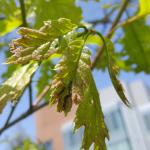
 Gypsy Moth: Lymantria dispar caterpillar dispersal (ballooning) is well under way in most locations where this insect has been recently problematic in Massachusetts. See previous Landscape Messages and the “Insects” section for more information regarding prior 2017 observations. Gypsy moth dispersal via ballooning may be at an end, along with egg hatch, which has been occurring over the past several weeks. To be sure, monitor local gypsy moth egg masses (to be sure no caterpillars are still resting on top of the masses) and look for tattered host plant foliage with young, still small gypsy moth caterpillars feeding beneath. Egg hatch has been staggered over this period, as not all eggs hatch at once. The young caterpillars that hatched in the previous weeks (beginning around the end of April through May) are actively feeding at this time. If you find a host plant leaf with small, tattered holes in it, flip the leaf over and you may find a small, roughly ¼-½-inch long gypsy moth caterpillar feeding on the leaf underside. These caterpillars are dark in color and hairy, but at this time, the blue and red raised “wart-like” spots on the back are not yet as apparent as they will be in the older caterpillars. See the Regional Reports above for more information about gypsy moth activity. Over the past few weeks, gypsy moth caterpillars have unfortunately been observed on the UMass Amherst campus, despite an apparent lack of readily visible egg masses. Research suggests that young gypsy moth caterpillars can balloon into an area from at least a mile away. See the Pioneer Valley Region report for information regarding plants these caterpillars have been observed on locally. For more information about gypsy moth egg hatch, please visit: https://ag.umass.edu/landscape/news/gypsy-moth-egg-hatch-has-begun-in-massachusetts.
Gypsy Moth: Lymantria dispar caterpillar dispersal (ballooning) is well under way in most locations where this insect has been recently problematic in Massachusetts. See previous Landscape Messages and the “Insects” section for more information regarding prior 2017 observations. Gypsy moth dispersal via ballooning may be at an end, along with egg hatch, which has been occurring over the past several weeks. To be sure, monitor local gypsy moth egg masses (to be sure no caterpillars are still resting on top of the masses) and look for tattered host plant foliage with young, still small gypsy moth caterpillars feeding beneath. Egg hatch has been staggered over this period, as not all eggs hatch at once. The young caterpillars that hatched in the previous weeks (beginning around the end of April through May) are actively feeding at this time. If you find a host plant leaf with small, tattered holes in it, flip the leaf over and you may find a small, roughly ¼-½-inch long gypsy moth caterpillar feeding on the leaf underside. These caterpillars are dark in color and hairy, but at this time, the blue and red raised “wart-like” spots on the back are not yet as apparent as they will be in the older caterpillars. See the Regional Reports above for more information about gypsy moth activity. Over the past few weeks, gypsy moth caterpillars have unfortunately been observed on the UMass Amherst campus, despite an apparent lack of readily visible egg masses. Research suggests that young gypsy moth caterpillars can balloon into an area from at least a mile away. See the Pioneer Valley Region report for information regarding plants these caterpillars have been observed on locally. For more information about gypsy moth egg hatch, please visit: https://ag.umass.edu/landscape/news/gypsy-moth-egg-hatch-has-begun-in-massachusetts.
To treat individual, landscape ornamental and shade trees using the active ingredient Btk (Bacillus thuringiensis Kurstaki) for gypsy moth, be sure that the newly hatched caterpillars have settled to feed on fully expanded foliage and are roughly between ¼ - ¾ inch in length. Larger caterpillars are less susceptible to Btk. These applications should be made when very young caterpillars are actively feeding on host plant leaves, as it must be ingested to be effective. Spinosad is effective on older gypsy moth caterpillars (over ¾ inch in length) but should not be applied to plants while they are in bloom due to the risk toward pollinators.
Gypsy moth host plants include but are not limited to oak (favored), maple, birch, poplar, and many others. Caterpillars will feed on conifers (such as eastern white pine, hemlock, and spruce) when favored resources have been exhausted. (Note: winter moth and gypsy moth share some common host plants. Therefore, where populations of these two insects overlap in Massachusetts, the same tree may be defoliated by winter moth and then again by gypsy moth following in the same season.) Caterpillar dispersal occurs by crawling to the canopy of their host plant, where they can scatter using a technique known as “ballooning”. Ballooning occurs when very young caterpillars spin a silken thread and catch the wind to blow onto a new host plant once the thread breaks. This method of dispersal can lead to host plants becoming defoliated that previously did not have egg masses directly on them, however egg masses may be present on nearby oaks, for example, and provide a local population of caterpillars.
Patchy areas across mostly central and eastern Massachusetts experienced elevated populations of gypsy moth and significant amounts of defoliation in 2016 (see the Insects section of the archived 2016 Landscape Messages between April 29 and July 29). The Massachusetts Department of Conservation and Recreation aerially mapped approximately 350,000 acres of defoliation across Massachusetts last year, attributed to gypsy moth. State officials warn the public about another year of defoliation from gypsy moth as predicted for 2017: http://www.mass.gov/eea/agencies/dcr/pr-2017/another-year-of-defoliation-from-gypsy-moth-in-2017.html. That web page also links to a map of the 2016 defoliation from gypsy moth, which may provide a reference regarding areas that may be impacted by this insect again in 2017.
We need the more “normal” rainfall amounts (non-drought conditions) that we have been experiencing to continue through May and June, to help facilitate the successful infection of younger gypsy moth caterpillars with the insect-killing fungus Entomophaga maimaiga. However, at this time, it is too early to know what impact this fungus will have on the 2017 gypsy moth population. It is also important to note that even with fungal infection in the caterpillars, we may still see significant defoliation in certain areas of Massachusetts this year due to this insect. This fungus overwinters in the soil litter in tough, protected asexual resting spores, which can survive in this state for years. Having lacked much precipitation most recently during the springs of 2015 and 2016, it is thought that our current expanding populations of gypsy moth are at least in part a result of a lack of infection in the caterpillar population by this fungus. Hopefully Massachusetts will continue to see more normal rainfall amounts this season. Only time will tell. So far, according to reports from the Northeast Regional Climate Center, last month (April) showed most (not all) of Massachusetts at or above normal precipitation amounts for that month. As a region, they report from the U.S. Drought Monitor that the Northeast became free of severe drought for the first time since late June 2016 (reported on 4/27/17). See: http://www.nrcc.cornell.edu/regional/drought/drought.html.
We can also hope areas in Massachusetts that did not experience much gypsy moth defoliation last year (areas such as most of Berkshire County) will be mostly spared in 2017 in comparison to those areas who suffered last year in southern central and eastern Massachusetts. However, due to the ballooning ability of the young caterpillars, where egg masses may exist nearby, previously unaffected host plants may be found to have gypsy moth caterpillars present on them this year. For more information about gypsy moth, please visit: http://ag.umass.edu/landscape/fact-sheets/gypsy-moth and return to the Landscape Message for timely updates about this pest and others throughout the season. An excellent article written by Dr. Joseph Elkinton and Jeff Boettner of the University of Massachusetts about the 2016 outbreak and the history of this insect in Massachusetts may be found here: http://www.mass.gov/eea/agencies/dfg/dfw/publications/gypsy-moth-outbreak-of-2016.html.
- Winter Moth: Operophtera brumata. For more information about the life cycle and management of winter moth, please visit this newly updated (March, 2017) fact sheet: Winter Moth Identification and Management (https://ag.umass.edu/landscape/fact-sheets/winter-moth-identification-management).
Reports continue to indicate that in certain areas this year, winter moth caterpillar numbers are reduced. See Regional Reports above for updates regarding current winter moth activity. Dr. Joseph Elkinton and his lab team at the University of Massachusetts report that when sampling for winter moth this season in host plant buds, at most of their research sites they are observing greatly reduced winter moth numbers this year. Dr. Elkinton reports that in past similar surveys, it was not uncommon to find 20+ winter moth caterpillars per host plant bud sampled. In the 2017 season, at most of their research sites, the Elkinton lab reports finding roughly 1-2 caterpillars every other bud or so that is sampled. At this time, this information is still largely anecdotal, but more information about winter moth will become available as the season progresses. Please see the Regional Reports above for local information regarding this insect.
For individuals managing winter moth in ornamental plants, spinosad is effective through ingestion and contact on winter moth (including older caterpillars) once ornamental plant leaves have fully expanded, however it should not be applied to plants in flower as it is toxic to pollinators until it has dried (which can take 1-3 hours depending upon local environmental conditions). For more in-depth information regarding winter moth management, see the Identification and Management Fact Sheet above.
Winter moth is a non-native insect that was identified in Massachusetts for the first time in 2003 following persistent reports of defoliation in eastern areas of the state such as Cape Anne and on the North Shore near Cohasset, Hingham, and Rockland on the South Shore in the late 1990’s. For more detailed information about the history of this insect pest in North America and Massachusetts, please visit the newly updated (March, 2017) fact sheet: Winter Moth in Massachusetts: History and Biological Control (https://ag.umass.edu/landscape/fact-sheets/winter-moth-in-massachusetts-history-biological-control).
This fact sheet also includes updates regarding the progress of the work of Dr. Joseph Elkinton’s laboratory group at the University of Massachusetts and their efforts towards the biological control of winter moth using Cyzenis albicans, a tachinid fly. The fly parasitizes the caterpillars of winter moth specifically. In other areas, such as Nova Scotia where winter moth was also problematic, this fly used for biological control has been successful in reducing winter moth to a non-pest. C. albicans has been released across 41 sites in Massachusetts and has been established in at least 17 of those sites as evidenced through the recovery of flies in winter moth in subsequent years. In one site in Wellesley, these flies have been observed to be spreading from the initial release location and their populations have increased alongside an observed decrease in the winter moth population there. For more information, please visit the above mentioned fact sheet.
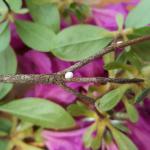
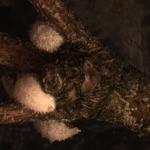
 Azalea Bark Scale: Eriococcus azaleae was discovered in CT in 1917 and has since been reported in other states. It is found on the bark of twigs and stems and commonly settles in branch crotches. It has been reported on azalea, rhododendron, andromeda, and others. Female scales are approximately 2-3 mm. in length and covered in a white, waxy coating. The females are purple in color and may resemble a mealybug, although they are a soft or felt scale. These females have overwintered and are going to lay eggs which will hatch into crawlers toward the end of June through mid-July. Crawlers will settle into branch crotches, bark crevices, or on the axils of leaves. There is a parasitic wasp that will attack these insects. When high in number, these scales can cause yellowing of the foliage and their sugary excrement can lead to the promotion of sooty mold. Because these are soft scales, they may be targeted with horticultural oils or insecticidal soaps while observing label instructions to prevent phytotoxicity.
Azalea Bark Scale: Eriococcus azaleae was discovered in CT in 1917 and has since been reported in other states. It is found on the bark of twigs and stems and commonly settles in branch crotches. It has been reported on azalea, rhododendron, andromeda, and others. Female scales are approximately 2-3 mm. in length and covered in a white, waxy coating. The females are purple in color and may resemble a mealybug, although they are a soft or felt scale. These females have overwintered and are going to lay eggs which will hatch into crawlers toward the end of June through mid-July. Crawlers will settle into branch crotches, bark crevices, or on the axils of leaves. There is a parasitic wasp that will attack these insects. When high in number, these scales can cause yellowing of the foliage and their sugary excrement can lead to the promotion of sooty mold. Because these are soft scales, they may be targeted with horticultural oils or insecticidal soaps while observing label instructions to prevent phytotoxicity.
- Black Vine Weevil: Otiorhynchus sulcatus damage is apparent on rhododendron and taxus, but can also be seen on azalea, mountain laurel, and Euonymus. Adult weevils feed along the leaf/needle margins and create rounded notches. Inspect foliage of these plants for notching from last season’s feeding. Larvae, which dwell in the soil, are conducting their heaviest feeding on plant roots at this time. Pupation will occur by the end of this month. Adults will emerge in June and create new damage to leaves for this season. All individuals are females and reproduce asexually. This insect has developed resistance to many chemical insecticides. Entomopathogenic nematodes such as Steinernema carpocapsae, S. feltiae, and Heterorhabditis bacterio-phora work well against this insect, particularly on containerized plants. Results in the landscape vary. Wetting the soil thoroughly prior to application and keeping it wet for at least 5 days following application can help increase the efficacy of the nematodes. Burlap laid around the base of plants during the time adults are active, by the end of May through August, can be inspected weekly for adult weevils which can be killed before egg laying.
- Boxwood Psyllid: Psylla buxi is feeding on boxwood foliage with its piercing-sucking mouthparts. This feeding may not cause yellowing or loss of foliage, but will lead to the cupping of new leaves which can be an aesthetic issue for some. If population numbers are low, management of this pest may not be necessary. Nymphs of this insect may be managed between 290-440 GDD’s.
- Eastern Tent Caterpillar: Malacosoma americanum (ETC) tents continue to grow in size and are increasingly noticeable in certain areas of the state. Scout for, remove, and destroy any eastern tent caterpillar tents in the crotches of branches on susceptible hosts such as cherry and crabapple. If the tents and the growing caterpillars within are found early enough, this is a great way of removing these insects without the use of chemicals. Other host plants impacted by this native insect can include apple, ash, birch, willow, maple, oak, poplar, and witch-hazel. For a photo demonstration on how to mechanically manage ETC, please visit the following Buckeye Yard & Garden onLine report from Joe Boggs of the Ohio State University Extension. Warning, reader discretion is advised: http://bygl.osu.edu/node/733.
- Elongate Hemlock Scale: Fiorinia externa is found on eastern, Carolina, and Japanese hemlock, as well as yew, spruce, and fir. Crawlers will be present this month and throughout the growing season and the overlap of many developmental stages at any given time can be observed.
- European Pine Sawfly: Neodiprion sertifer caterpillars or sawflies are active. Reports of this insect on Mugo pine were made on 4/27/17 in Framingham. At that time, the tiny, newly hatched sawflies were still located on the very needles from which they emerged. For other locations, see the Regional Reports above. The primary host in MA is Mugo pine but it can be found on Scots, red, jack, and Japanese red pine, but is also found on white, Austrian, ponderosa, shortleaf, and pitch pine when near the aforementioned species. This dark colored caterpillar feeds in tight groups and small numbers can be pruned away and destroyed. Larger numbers can be treated with an insecticidal soap spray when the caterpillars are still small. Spinosad products can be used whenever the caterpillars are actively feeding, usually by mid-May and when caterpillars are still small. Bacillus thuringiensis Kurstaki is not effective against sawflies.
- Forest Tent Caterpillar: Malacosoma disstria (FTC) caterpillars continue to feed on maple and oak and were observed on 5/17/17 to be approximately 1 inch in length in Amherst. Other susceptible hosts such as birch, ash, elm, poplar, and basswood may also be fed upon by these caterpillars. These native caterpillars can defoliate their host plants, but are not currently in large populations in all areas in the state. In 2016, certain forested locations in Berkshire County supported ample numbers of these caterpillars. Neighboring states also reported some increased activity by this native insect such as in Vermont (http://bit.ly/2qAoxkR) and New Hampshire (https://nhbugs.org/forest-tent-caterpillar). It will be interesting to keep an eye on the Massachusetts population.
- Hemlock Looper: Two species of geometrid moths in the genus Lambdina are native insects capable of defoliating eastern hemlock, balsam fir, and white spruce. Adult moths lay their eggs on the trunk and limbs of hosts in September and October, and eggs will hatch by late May or early June. Monitor susceptible hosts for small, inch-worm like caterpillars. Where populations are low, no management is necessary.

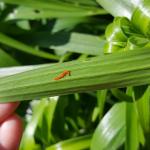
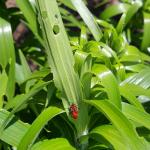 Lily Leaf Beetle: Lilioceris lilii adult beetles were observed causing feeding damage, mating, and eggs were laid on plants in Amherst. See Regional Reports for local activity of this insect. Management can be achieved by hand-picking and removing adults and larvae. Some chemical management options are available for this insect, but if caught early mechanical management may be effective.
Lily Leaf Beetle: Lilioceris lilii adult beetles were observed causing feeding damage, mating, and eggs were laid on plants in Amherst. See Regional Reports for local activity of this insect. Management can be achieved by hand-picking and removing adults and larvae. Some chemical management options are available for this insect, but if caught early mechanical management may be effective.
The University of Rhode Island Biological Control Lab is researching ways to find a natural method to combat these beetles. Small parasitic insects have been established in lily plots in Cumberland, RI and Wellesley, MA in hopes that these insects will disperse naturally to reduce the effects of the lily leaf beetle. If you have larvae in your yard (or a customer’s yard), please send to URI, following the instructions on the URI Biocontrol Lab website: http://web.uri.edu/biocontrol/home/lily-leaf-beetle-larval-collections-2016-mailing-instructions/
- Roseslugs: Two species of sawfly can be found on the leaves of roses at this time. These small, caterpillar-like larvae will skeletonize the upper leaf surface and leave a “window-pane” like pattern behind. When present in large numbers, these insects are capable of defoliating their entire host. Management options include an insecticidal soap spray or a product containing spinosad.

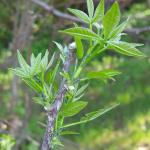
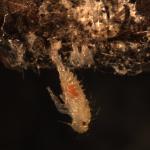
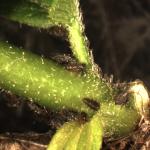
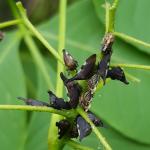 Two-marked Tree Hopper: The Enchenopa binotata species complex is now thought to be made up of very closely related Enchenopa spp. that are morphologically very similar but separated by the different host plants that they are found on. These particular treehoppers are found on black walnut, wafer ash (Ptelea trifoliata), and viburnum. These insects will feed on the host plants with piercing-sucking mouthparts and drink plant juices from the leaves and petioles. Leaves will become shiny and sticky with their excrement. Eggs that were laid last season and overwintered have now hatched on wafer ash as the leaves of the plant are just emerging. Eggs are laid by adult females using saw-like ovipositors to insert them into plant stems. Eggs are then covered with a vivid white, sticky, frothy material that protects them but can easily be mistaken for a scale insect. Eggs have hatched and the tiny, young nymphs can be seen feeding at this time. These treehoppers, whether by their feeding activity or egg laying behavior into plant stems, are not considered to be damaging pests (even when high in numbers) and therefore management is generally not required.
Two-marked Tree Hopper: The Enchenopa binotata species complex is now thought to be made up of very closely related Enchenopa spp. that are morphologically very similar but separated by the different host plants that they are found on. These particular treehoppers are found on black walnut, wafer ash (Ptelea trifoliata), and viburnum. These insects will feed on the host plants with piercing-sucking mouthparts and drink plant juices from the leaves and petioles. Leaves will become shiny and sticky with their excrement. Eggs that were laid last season and overwintered have now hatched on wafer ash as the leaves of the plant are just emerging. Eggs are laid by adult females using saw-like ovipositors to insert them into plant stems. Eggs are then covered with a vivid white, sticky, frothy material that protects them but can easily be mistaken for a scale insect. Eggs have hatched and the tiny, young nymphs can be seen feeding at this time. These treehoppers, whether by their feeding activity or egg laying behavior into plant stems, are not considered to be damaging pests (even when high in numbers) and therefore management is generally not required.
- Viburnum Leaf Beetle: Pyrrhalta viburni is a beetle in the family Chrysomelidae that is native to Europe, but was found in Massachusetts in 2004. See the Regional Reports regarding areas where this insect has been noted to be active thus far this season. This beetle feeds exclusively on many different species of viburnum including but not limited to susceptible plants such as V. dentatum, V. nudum, V. opulus, V. propinquum, and V. rafinesquianum. Larvae may be treated with a product containing spinosad. Some viburnum have been observed to have varying levels of resistance to this insect, including but not limited to V. bodnantense, V. carlesii, V. davidii, V. plicatum, V. rhytidophyllum, V. setigerum, and V. sieboldii. More information about viburnum leaf beetle may be found at http://www.hort.cornell.edu/vlb/.
- White Spotted Pine Sawyer (WSPS): Monochamus scutellatus will be pupating this month and adults can emerge in late May throughout July, depending on local temperatures. This is a native insect in Massachusetts and is usually not a pest. Larvae develop in weakened or recently dead conifers, particularly eastern white pine (Pinus strobus). However, the white spotted pine sawyer looks very similar to the invasive Asian Longhorned Beetle, Anoplophora glabripennis, ALB. ALB adults do not emerge in Massachusetts until July and August. Beginning in July, look for the key difference between WSPS and ALB adults, which is a white spot in the top center of the wing covers (the scutellum) on the back of the beetle. White spotted pine sawyer will have this white spot, whereas Asian longhorned beetle will not. Both insects can have other white spots on the rest of their wing covers; however, the difference in the color of the scutellum is a key characteristic. See the Asian longhorned beetle entry below for more information about that non-native insect.
- Chilli Thrips: *A non-native insect has been confirmed in Massachusetts for the first time.* The non-native, exotic chilli thrips (Scirtothrips dorsalis) has been recently confirmed from two samples of damaged Hydrangea spp. foliage from two residential landscapes located in Barnstable County, MA submitted to the UMass Plant Diagnostics Laboratory. At this time, this pest has not been confirmed in nurseries or greenhouses in Massachusetts or on any other host plants. Due to the limited number of samples, the significance of chilli thrips in Massachusetts is not yet known. This species of thrips is a significant global pest of economically important ornamental, vegetable, and fruit crops in southern and eastern Asia, Oceania, and parts of Africa. It was first determined to be established in the United States in 2005 in Florida, although previous interceptions of this pest were detected. It is reportedly a pest of over 100 host plants belonging to over 40 plant families, including, but not limited to, pepper, strawberry, blueberry, cotton, rose, peanut, Japanese privet, Rhododendron spp., Viburnum spp., eggplant, grapes, melon, tobacco, and tomato. For more information, please visit this Chilli Thrips Fact Sheet (https://ag.umass.edu/landscape/fact-sheets/chilli-thrips) available on the UMass Extension Landscape, Nursery, and Urban Forestry Program web page.
- Asian Longhorned Beetle, Anoplophora glabripennis, ALB: Look for signs of an ALB infestation which include perfectly round exit holes (about the size of a dime), shallow oval or round scars in the bark where a female has chewed an egg site, or sawdust-like frass (excrement) on the ground nearby host trees or caught in between branches. Be advised that other, native insects may create perfectly round exit holes or sawdust-like frass, which can be confused with signs of ALB activity.
The regulated area for Asian longhorned beetle is 110 miles2 encompassing Worcester, Shrewsbury, Boylston, West Boylston, and parts of Holden and Auburn. If you believe you have seen damage caused by this insect, such as exit holes or egg sites, on susceptible host trees like maple, please call the Asian Longhorned Beetle Eradication Program office in Worcester, MA at 508-852-8090 or toll free at 1-866-702-9938. Adult insects of this species will not be present at this time of year.
To report an Asian longhorned beetle find online or compare it to common insect look-alikes, visit: http://massnrc.org/pests/albreport.aspx or https://www.aphis.usda.gov/pests-diseases/alb/report.
- Emerald Ash Borer (EAB): Agrilus planipennis readily attacks ash (Fraxinus spp.) including white, green, and black ash and has also been found developing in white fringe tree (Chionanthus virginicus). Adult insects of this species will not be present at this time of year. Signs of an EAB infested tree may include (at this time) D-shaped exit holes in the bark (from adult emergence in previous years), “blonding” or lighter coloration of the ash bark from woodpecker feeding (chipping away of the bark as they search for larvae beneath), and serpentine galleries visible through splits in the bark, from larval feeding beneath. Positive identification of an EAB-infested tree may not be possible with these signs individually on their own.
For a map of the known locations of emerald ash borer in the state, as well as further information about this insect, please visit: https://ag.umass.edu/fact-sheets/emerald-ash-borer. If you believe you have located EAB-infested ash trees, particularly in an area of Massachusetts not identified on the map provided, please follow the instructions below.
Concerned that you may have found an invasive insect or suspicious damage caused by one? Need to report a pest sighting? If so, please visit the Massachusetts Introduced Pests Outreach Project: http://massnrc.org/pests/pestreports.htm.
A note about Tick Awareness: deer ticks (Ixodes scapularis), the American dog tick (Dermacentor variabilis), and the lone star tick (Amblyomma americanum) are all found throughout Massachusetts. Each can carry their own complement of diseases. Anyone working in tick habitats (wood-line areas, forested areas, and landscaped areas with ground cover) should check themselves regularly for ticks while practicing preventative measures. Have a tick and need it tested? Visit the web page of the UMass Laboratory of Medical Zoology (www.tickdiseases.org) and click on the red Test a Tick button for more information.
For information about managing ticks in landscapes, among other topics, please visit the following publication from the Connecticut Agricultural Experiment Station: “Tick Management Handbook”: http://www.ct.gov/caes/lib/caes/documents/publications/bulletins/b1010.pdf.
Report by Tawny Simisky, Extension Entomologist, UMass Extension Landscape, Nursery, & Urban Forestry Program
Management Practices
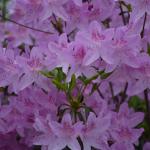
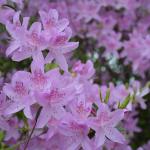 Plant of the week: Rhododendron yedoense var. poukhanese Korean azalea
Plant of the week: Rhododendron yedoense var. poukhanese Korean azalea
Rhododendron spp. are having a great spring! Rhododendron yedoense var. poukhanese is a deciduous shrub in our northern climate but can be evergreen where winter is mild. It is a low to medium shrub growing 3-6’ tall but spreading about twice as wide. The flowers are 2” wide, slightly fragrant, lavender to rose pink with pink blotches on the upper petals. Flower buds have great cold hardiness leading plants to be covered in flowers in May. Leaves are elliptical and dark green in summer changing to orange to red-purple in fall. Plants are best grown in a well-drained, acidic soil in part shade to full shade. Poor drainage can lead to root rot in many Rhododendron species, but Rhododendron yedoense var. poukhanese is said to have good resistance. Mulching helps to retain moisture, preventing stress and problems. Rhododendron species can suffer from a variety of problems from canker to lacebugs to scale, but generally healthy plants have limited problems. Korean azalea is a great choice in a woodland or shade garden, in mass or as a specimen.
Report by Mandy Bayer, Extension Assistant Professor of Sustainable Landscape Horticulture, UMass Stockbridge School of Agriculture
Additional Resources
To receive immediate notification when the next Landscape Message update is posted, be sure to join our e-mail list and follow us on Facebook and Twitter.
For a complete listing of upcoming events, see our Upcoming Educational Events page.
For commercial growers of greenhouse crops and flowers - Check out the New England Greenhouse Update website
For professional turf managers - Check out Turf Management Updates
For home gardeners and garden retailers - Check out home lawn and garden resources. UMass Extension also has a Twitter feed that provides timely, daily gardening tips, sunrise and sunset times to home gardeners, see https://twitter.com/UMassGardenClip
Diagnostic Services
A UMass Laboratory Diagnoses Landscape and Turf Problems - The UMass Extension Plant Diagnostic Lab is available to serve commercial landscape contractors, turf managers, arborists, nurseries and other green industry professionals. It provides woody plant and turf disease analysis, woody plant and turf insect identification, turfgrass identification, weed identification, and offers a report of pest management strategies that are research based, economically sound and environmentally appropriate for the situation. Accurate diagnosis for a turf or landscape problem can often eliminate or reduce the need for pesticide use. For sampling procedures, detailed submission instructions and a list of fees, see Plant Diagnostics Laboratory
Soil and Plant Nutrient Testing - The University of Massachusetts Soil and Plant Nutrient Testing Laboratory is located on the campus of The University of Massachusetts at Amherst. Testing services are available to all. The function of the Soil and Plant Nutrient Testing Laboratory is to provide test results and recommendations that lead to the wise and economical use of soils and soil amendments. For complete information, visit the UMass Soil and Plant Nutrient Testing Laboratory web site. Alternatively, call the lab at (413) 545-2311.
Ticks are active at this time! Remember to take appropriate precautions when working and playing outdoors, and conduct daily tick checks. UMass tests ticks for the presence of Lyme disease and other disease pathogens. Learn more